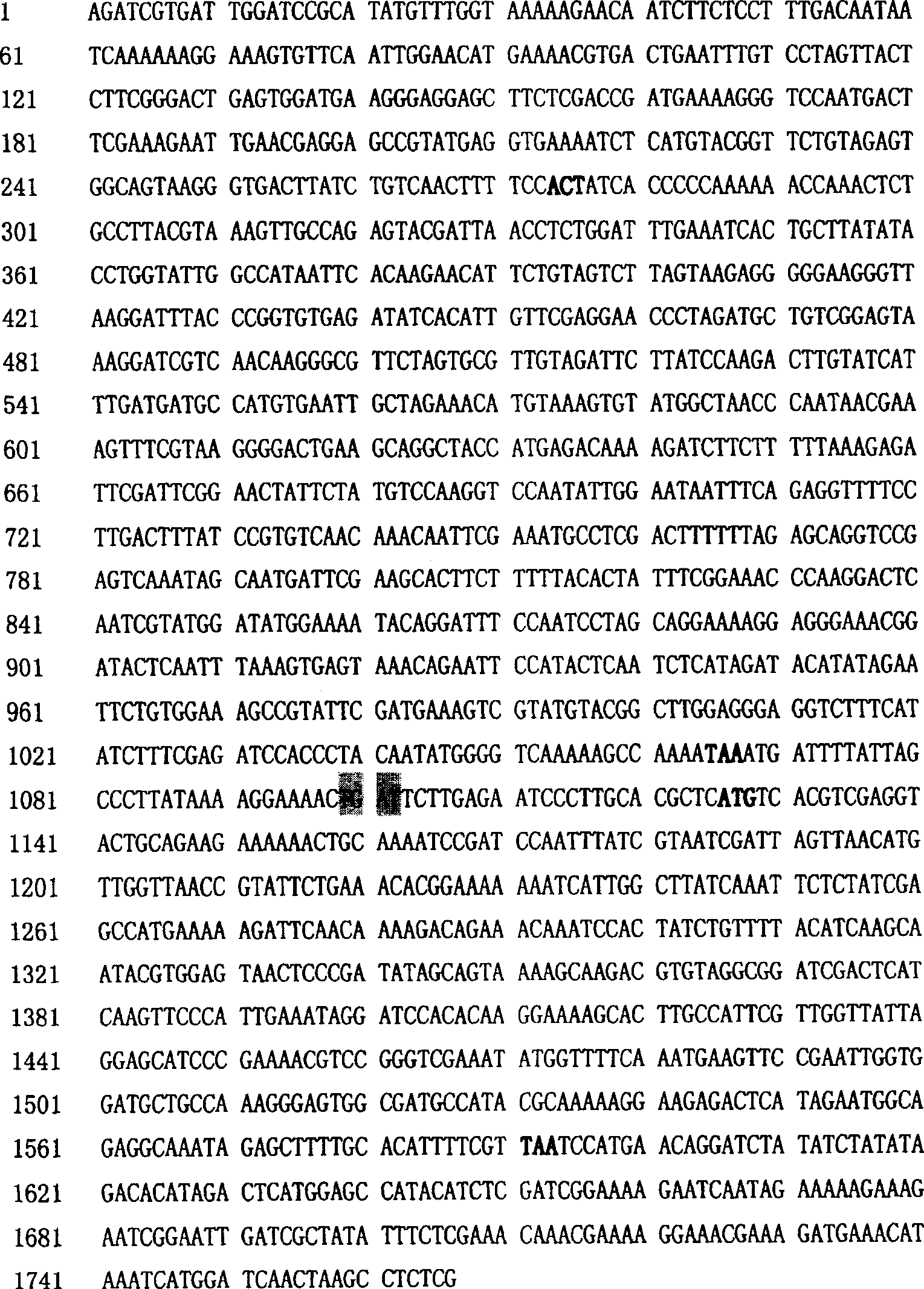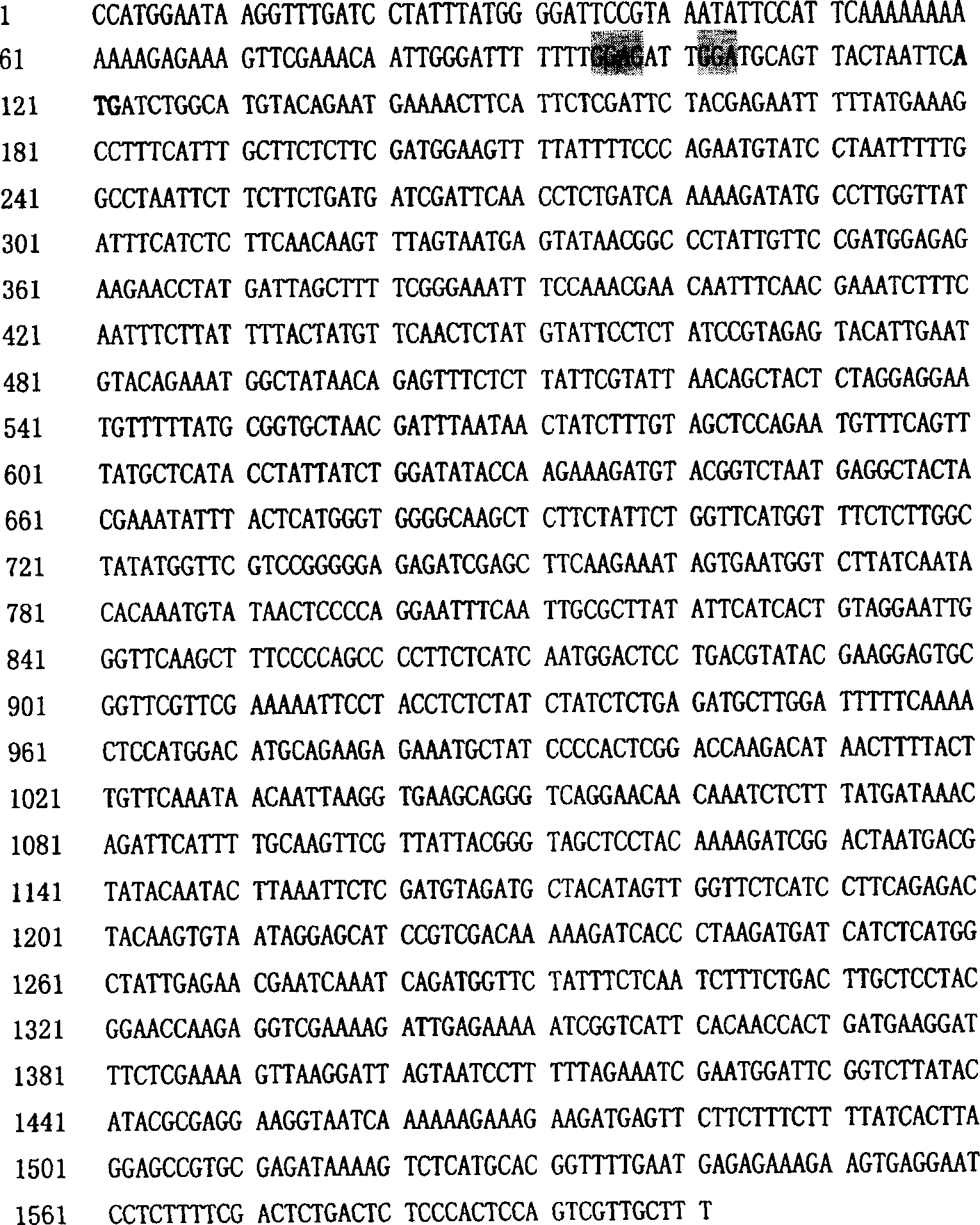Poplar chloroplast site-specific transformation method and DNA sequence for said method
A technology of DNA sequence and chloroplast, which is applied in the field of DNA sequence to achieve the effect of high expression efficiency, good safety, and reduced chance of variation and deformity
- Summary
- Abstract
- Description
- Claims
- Application Information
AI Technical Summary
Problems solved by technology
Method used
Image
Examples
Embodiment 1
[0029] Cloning of Two Poplar Chloroplast DNA Fragments and Construction of Chloroplast Transformation Vector
[0030] 1. Amplification and cloning of two chloroplast DNA fragments of poplar
[0031] Design and synthesize the following two pairs of primers:
[0032] P1: 5'-GCG GGT ACC GAG CAG GCT ACC ATG AG-3’
[0033] KpnI
[0034] P2: 5'-CGC GGG CCC CGA GAG GCT TAG TTG ATC-3’
[0035] ApaI
[0036] P3: 5'-GCG GCG GCC GC C CAT GGA ATA AGG TTT GAT-3’
[0037] NotI
[0038] P4: 5'-CGC CCG CGG AAA GCA ACG ACT GGA GTG-3’
[0039] SacII
[0040] Using poplar chloroplast DNA as a template, amplified by P1 and P2 primers, the PCR reaction was carried out on a Perkin-Elmer PE480 DNA amplification instrument, and the reaction program was: 95°C for 5min (one cycle); 95°C for 1min, 48°C 1min, 72°C 1min30sec (30 cycles); 72°C 10min. The PCR amplified product was about 1.7kb. The PCR product purified by phenol-chlo...
Embodiment 2
[0046] Expression of Green Fluorescent Protein (GFP) Gene in Chloroplasts of Poplar and Establishment of Efficient Chloroplast Transformation System
[0047] 1. Carrier:
[0048] Poplar Chloroplast Site-directed Transformation Expression Vector pPZG Containing GFP Gene
[0049]2. Transformation acceptor material:
[0050] Poplar tomentosa (Populus tomentosa Carr.) sterile vaccine
[0051] 3. Gene transformation:
[0052] The leaves of poplar were transformed by gene gun method. First, a large amount of high-quality plasmid DNA was prepared. The preparation method was improved by our laboratory, so that high-quality DNA could be prepared and diluted to 1 μg / μl for transformation. Then prepare microparticle bullets according to conventional methods, bombard the poplar leaves treated with hyperosmosis for 4 hours with Bio-RadPDS-1000 / He gene gun, then treat with hyperosmosis for 16 hours, then transfer to differentiation medium and cultivate for four days, then transfer Diff...
Embodiment 3
[0064] High-efficiency expression of Bt toxin protein gene in chloroplast and acquisition of transgenic insect-resistant poplar
[0065] 1. Carrier:
[0066] Poplar chloroplast site-directed transformation expression vector pPZB containing the Bt cryIA(a) gene cloned by our laboratory
[0067] 2. Transformation acceptor material:
[0068] Poplar tomentosa (Populus tomentosa Carr.) sterile vaccine
[0069] 3. Obtaining of chloroplast transformants:
[0070] The poplar chloroplast transformation system established in Example 2 was used to introduce the Bt gene into poplar chloroplasts and obtain transgenic plants (T0 generation). PCR detection was carried out on the transgenic plants, and the primers were specific primers for amplifying the Bt insecticidal protein gene, and 20 plants were detected as PCR positive plants. These positive plants were subjected to Southern hybridization analysis, and the hybridization probe was Bt insecticidal protein gene cryIA(a) labeled with ...
PUM
 Login to View More
Login to View More Abstract
Description
Claims
Application Information
 Login to View More
Login to View More - Generate Ideas
- Intellectual Property
- Life Sciences
- Materials
- Tech Scout
- Unparalleled Data Quality
- Higher Quality Content
- 60% Fewer Hallucinations
Browse by: Latest US Patents, China's latest patents, Technical Efficacy Thesaurus, Application Domain, Technology Topic, Popular Technical Reports.
© 2025 PatSnap. All rights reserved.Legal|Privacy policy|Modern Slavery Act Transparency Statement|Sitemap|About US| Contact US: help@patsnap.com



